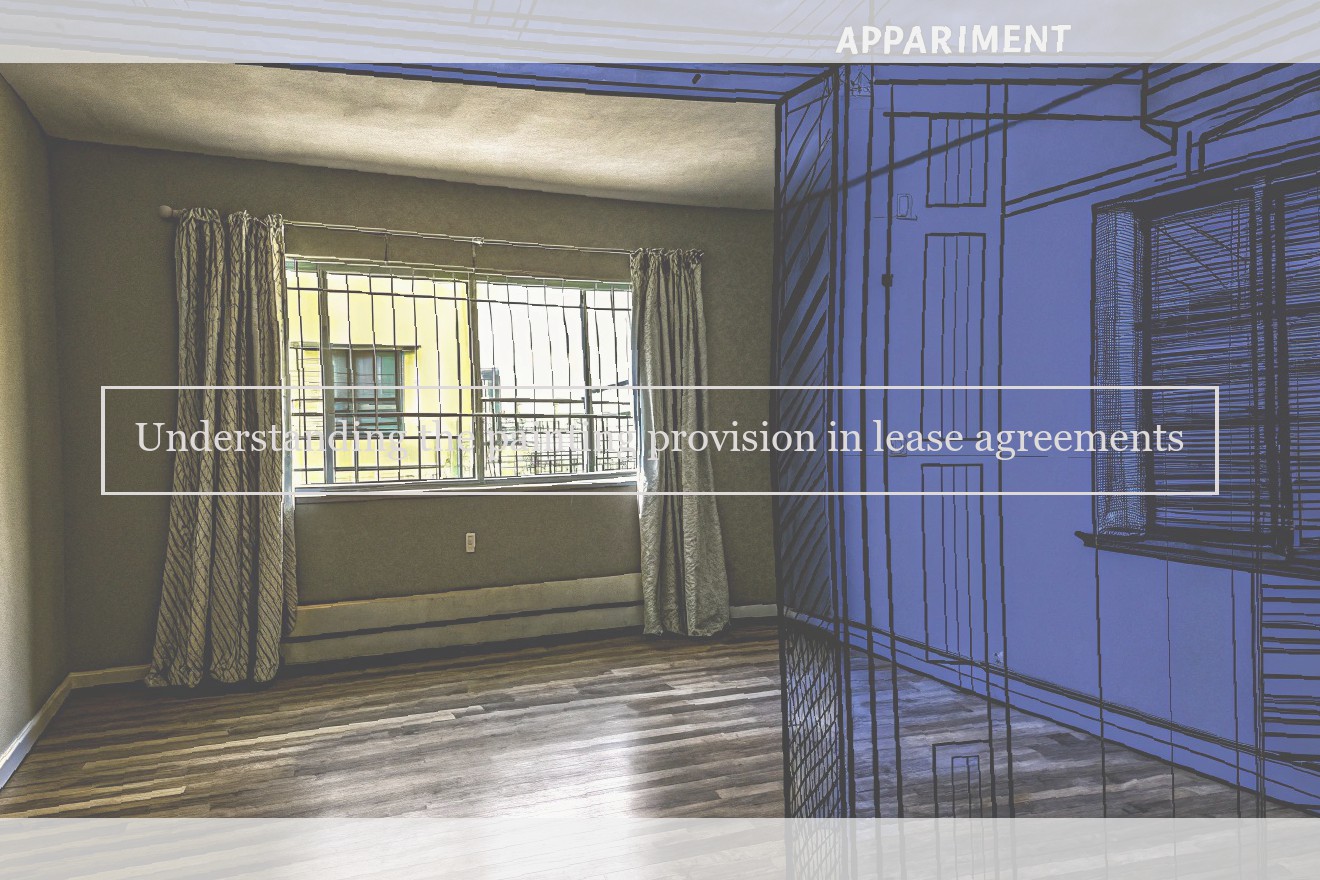What is a painting provision
A painting clause is a provision often included in rental agreements that assigns responsibility for maintaining the condition of the premises, particularly with respect to interior painting. Generally, landlords seek to include a painting clause to ensure that tenants are responsible for touching up and repainting walls as necessary during and at the end of the tenancy.
The typical intention of a painting clause is to ensure that the premises is painted at the end of the tenancy, either by the tenant or by a professional, with the cost reasonably shared between the landlord and the tenant. For example, a tenant may be required to bear the cost of a coat of fresh paint or any overhead work, while the landlord bears the cost of the basic materials. Similarly, the reinterpretation might state that the cost of paint will be split while the tenant bears the labour costs which might be higher where scaffolding is needed to do window trim . There are a number of factors to take into consideration when determining a reasonable allocation of the cost, such as who is installing the flooring and how long the tenant is residing in the unit.
Because of the relatively small cost sometimes associated with fresh paint, some courts have questioned the enforceability of painting clauses, arguing it would be an undue hardship on the tenant to require them to bear the cost of painting. The result in each case will depend on both the wording and interpretation of the particular clause, as well as the amounts at issue.
In the case of blanket painting clauses, where the tenant is required to paint any portions of the unit that require painting without regard to actual need, it is advisable that the clause contain a limitation as to the number of times the tenant would be responsible for the painting over a certain period of time. Failing to do so may result in an inability to claim for a damage award for painting in the event significant wear and tear occurs and a paint colour change needs to occur after a number of years.
Importance of painting provisions
The painting clause in a rental agreement is important as it outlines the responsibilities of the tenant and landlord with respect to the maintenance or replacement of wall coverings. This clause benefits both the landlord and the tenant. If a painting clause is inserted in an agreement, the tenant will be aware of his or her responsibility to make sure that the interior of the rental unit is properly maintained, while the landlord will be aware of the substantial monetary expense involved with repainting a rental unit.
For landlords, the major benefit of inserting a painting clause in a rental agreement is that the cost of repainting the interior of the rental unit (wear and tear from regular use excepted) will not automatically fall on his or her shoulders. The tenant will know that regardless of whether he or she damages the wall coverings, leasing out the rental unit to a new tenant will require that the existing tenancies be repainted (this can be costly). In order to alleviate any potential disputes when the lease ends, the responsibility of making sure the interior wall coverings are intact will be placed on the tenant.
For tenants, a major benefit of inserting a painting clause in a rental agreement is that the tenant is aware of exactly what her or she is responsible for; tenants do not want to find themselves in an situation in which a landlord claims the interior wall coverings are damaged and a deduction is made from a security deposit to cover the cost of repairs. A tenant is (frequently) not an expert in the cost of painting a rental unit, and a painting clause in the rental agreement will ensure nothing more is asked of the tenant.
There can be drawbacks to the inclusion of a painting clause in a rental agreement. From the landlord’s perspective, the major drawback is having responsibility of replacing the interior wall coverings; this can be a significant cost, and in some instances it may be preferable (and cost effective) for the landlord to simply deduct the costs of the damages with the tenant’s security deposit. For tenants, a drawback to a painting clause is that it may not be agreed to (or fully understood). A tenant may struggle to understand (and may even feel insulted) if a painting clause is requested in a residential lease agreement. It is important to remember that a one (1) year lease is often the first time a person has lived on his or her own, and a painting clause may be new and confusing. A tenant may be willing to negotiate a clause in which he or she is only responsible for any damages caused by intentional (i.e. malicious) actions, rather than the replacement of the entire interior wall coverings.
Tenant’s obligations to paint physically
A common question that we get is if the tenant has to repaint the premises and if so how often do they have to do it?
It is generally a requirement under the Residential Tenancies and Rooming Act 2008 (RTRA Act) that the premises are to be returned to the landlord in the same state and condition at the beginning of the tenancy unless specified otherwise in the tenancy agreement. As such a tenant is required to return the premises in the same state of condition as it was received, unless the landlord has agreed otherwise.
A rental property is considered to be in a good state of repair if it is fit for the tenant to reside in. A tenant is only required to keep the property in the same condition as it was in at the start of the tenancy, for the exceptions of fair wear and tear or for improvements or alterations requested or allowed by the landlord or property manager. A tenant is not required to paint a property if it was painted prior to or at the start of the tenancy. They are only required to return the property in the same condition as it was at the start of the tenancy. Arguments over paint colour are an example of the landlord trying to hold tenants accountable for things they are not liable for. A tenant cannot be required to return a rental property in a different paint colour to what the premises was returned in, and should not be penalised for leaving scuff marks and marks that are regular in daily life.
Requirements of a landlord and tenant with a painting provision
Landlords have the right to dictate the colour and type of décor that tenants are permitted to use to decorate their rented premises. Generally, landlords can refuse a tenant’s request to change the colour or type of décor by stating in the rental agreement that the tenant must not paint or change the décor of the unit, without obtaining the Landlord’s prior consent.
Section 12(3) of the RTA specifically provides that a landlord may specify in the rental agreement the manner in which the décor of a rental unit and the property around it may be changed. The agreement may specify what changes may be made; where those changes may be made; how the changes may be made and may provide for the restoration of the rental unit to its original condition.
Section 12(5) of the RTA does not give a landlord a blanket right to paint the unit at any time. It states that the landlord may enter the rental unit to inspect, maintain or repair a rental unit, or to determine whether to carry out work on a rental unit. Repainting walls and neutralizing décor would generally fall under a landlord’s duty to repair the rental unit.
There is a reverse obligation on a tenant to restore the rental unit to its original condition when the lease ends. Section 12(2) of the RTA imposes an obligation on tenants to restore rental units to their original condition at the end of the tenancy i.e. to re-paint the walls.
This obligates tenants to undo or rectify any changes made to the rental unit when the lease is terminated. If the rental agreement prohibits painting or permits painting with restrictions, tenants are required to comply with the requirement to restore and make good any changes when vacating the rental unit.
A landlord cannot unreasonably refuse a tenant’s request to perform painting or maintenance. A landlord is not entitled to demand a specific colour, nor can a landlord deny a tenant’s request for a reasonable painting schedule.
Dispute resolution regarding painting provisions
Even if a decision is made in advance between lessor and lessee, this does not mean that it automatically provides a basis which can be used as a definitive guide. In practice, legal disputes as to what kind of painting duties a person is responsible for are frequently heard before courts and tribunals.
The main cause for disputes arising between the parties is typically the interpretation of the provisions set out in the individual lease agreement. In particular, the provisions relating to the apportioning of maintenance work (including painting duties) between the lessor and the lessee are often interpreted differently by each party.
Another common cause for disputes is damage to the existing painting. This can result in a considerable overhaul of the existing painting, which can give rise to discussions as to whether a defect exists or whether the cause of the damage relies on circumstances beyond the influence of the lessee. If a defect is present this has to be repaired. In practice, damage to walls, ceiling and floor cannot be excluded, if the use of the unit has been heavy. Heavy use of a unit is regularly compensated for through the payment of an appropriate rent .
As a result of the implementation of a new general painting clause without any transitional provision by the lessor in a standard form rental agreement, the lessor was unable to exclusively enforce the new painting clause against the lessee who had already occupied the unit prior to the implementation of the new provisions. The Civil Chamber of the Court of Appeal (Oberlandesgericht, OLG) in Munich took the stance, that the new painting clause affected the essential interests of the lessee through the continuous adaption of the extent of duty of the lessee in relation to costs of the provided living space and it therefore represented an ex post facto alteration of the tenancy agreement. Since the new painting clause altered the tenancy agreement unilaterally and without written consent of the lessee, it was considered ineffective (Munich OLG, judgment dated 06.04.2012, 15 U 3462/11).
In order to avoid conflicts, it is important to reach an agreement in advance. It is recommended to clearly define the provisions within the respective lease agreement regarding the duties of the person responsible for the incurrence of costs for the cleaning, care and maintenance of walls, ceilings and floors. In determining the most suitable provision, the requirements of the specific property must be taken into account.
Tips for negotiating a painting provision
When negotiating a painting clause in a proposed rental agreement, some recommended terms to include are:
-tenants should only be required to paint the interior of a unit in a color selected by the landlord and at a time and in a manner directed by the landlord;
-the interior should be returned to its original condition prior to occupancy;
-the tenant should be permitted to replace and cover nails and holes; and
-the tenant should be responsible for the reasonable cost of repainting, with estimates subject to the landlord’s approval.
We think it is generally unreasonable for the unit interior to be left in "equal but different" condition, even if the colors may be similar, so tenants should confirm with their property managers that the unit will be painted the way it was when the tenant moved in. We also believe that tenants should not be required to have the painting done at their own cost.
Examples of painting provisions
Subsequent maintenance clause
You must give our managing agents written notice of the required repainting so that our managing agents can paint when needed. If you do not provide us with this notice, we have the right, at our discretion, to repaint the interior or exterior of the premises at your cost as required.
Alternative maintenance clause
You must give us the minimum notice of required repainting for either the exterior or interior of the premises (whichever is applicable) set out in the requirements for compliance with building regulation for our building or if we do not need to maintain the interior of the premises at all, we then at any time during the term may serve you a notice that we require the interior of the premises to be repainted.
Continuation of painting clause
If we enter into a further lease of the premises forthwith on or after the date which is the end of the term, you must on request ensure that the interior or exterior of the premises (whichever is applicable and which is the subject of our requisition under this clause) is freshly painted in accordance with the reasonable requirements of our managing agents within six months of the beginning of such further lease .
Longer than six month painting clause
If we enter into a further lease of the premises on or after the date which is the end of the term but within the period of six months from the beginning of that further lease, you must on request ensure that the interior or exterior of the premises (whichever is applicable and which is the subject of our requisition under this clause) is freshly painted in accordance with the reasonable requirements of our managing agents within the remainder of the term of such further lease.
Unique elements
As with all clauses in commercial leases or agreements for lease, there may be some unique elements to it. Whatever the situation, you can ensure that you fully understand how obligations can arise and when to provide adequate notice for these to be carried out.




+ There are no comments
Add yours